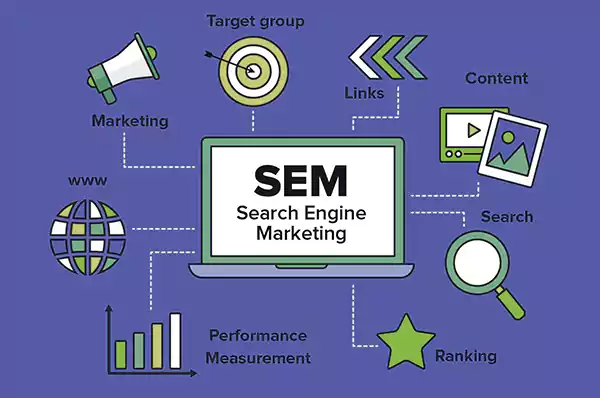SEM Services to Improve ROAS
Key Takeaways
- SEM calls for businesses to set aside a budget to execute search advertising.
- ROAS is used to have a zoomed-out view of the financial success or failure of a certain campaign.
- ROAS = Revenue from Advertising/ Cost of Advertising.
- ROAS reveals how much profit you make for each dollar spent on advertising.

Advertisements are undoubtedly an excellent way to reach the market and targeted audience. And as a marketer, you’ll probably need organic traffic but at an active speed. Without ads, you can gain an audience but in a saturated way, and it can take up to ages to gain strength.
Hence, spending dollars on advertising is a good idea, but the most imperative thing is to spend it effectively. Whether you run a social media campaign, paid search, or native ads, determining the impact the ads have on growth is fundamental.
In this article, we’ll look at how search engine marketing is utilized to improve return on ad spend. So, let’s start with understanding what SEM service is.
SEM Services

SEM (Search Engine Marketing) is often mixed up with search engine optimization, but there is a unique difference between both. SEM & SEO are related to one another in that they both use digital marketing techniques to increase traffic from search engines like Google & Bing.
SEM, on the other hand, typically calls for businesses to set aside a budget to execute search advertising, whereas SEO entails optimizing the website to generate traffic naturally without the need for additional spending. The company uses these commercial services to improve the ROAS of the company.
Pay per click, which requires firms to only invest when customers click on add, it’s another name for SEM. While SEO takes time to build up traffic organically through the creation of original content, it is a quick approach that businesses can use to bid on keywords and display their advertising above their competitors.
What is ROAS?
The ROAS ratio, which compares the amount of money you make to every dollar spent on advertising, is a technique to gauge how effectively your marketing initiatives are being spent.
While other measures (such as click-through or conversion rates) are meaningful in their own right, they don’t address whether your money is being used as efficiently as feasible. Return on ad spend offers a zoomed-out view of the financial success or failure of a certain campaign.
How to Calculate ROAS for Your E-commerce Business
Here’s how to compute ROAS now it makes sense as a measure. The ratio measures how much money an advertising drive made in comparison to how much it spent.
ROAS = Revenue from Advertising/ Cost of Advertising
Importance of ROAS in E-Commerce
It reveals how much profit you make for each dollar spent on advertising. It is a decisive statistic for assessing the effectiveness of your advertising initiatives and how they affect the bottom line of your business.
Making experts frequently utilize a target return on ad spend when organizing campaigns to assist control costs. Reverse engineer the algorithm to determine how much revenue you anticipate recovering from an advertising investment.
For eCommerce companies, the target return on ad spend should be the average conversion value that they expect to receive for every dollar spent on advertisement. Based on the nature company and product being sold, three to five times the return on ad spend ratio is a good number to aim for.
SEM Services to Improve ROAS
Advertising is a potentially creative industry. To stand out in today’s competitive business market; you must be innovative and think out of the box.
Though marketers must be evaluating figures and data to determine the efficiency of advertising initiatives. Because the ultimate goal of every marketing strategy is to generate income. This is where RoI comes into play.
Ad campaigns can perform poorly due to several reasons: poor audience targeting, a low click-through rate, or a low conversion rate. Ads are excellent to reach your market actively. However, you should understand the effectiveness of your commercial drives and ad spend ROAS is the main success benchmark of your efforts.
SEM services to improve the ROAS of companies is a powerful tool that businesses can use to increase their online visibility, drive traffic to their websites, and ultimately boost their bottom line. It is similar to ROI, but it only looks at the monetary return from a specific campaign. Without Tracking it, you might end up making optimal decisions based on limited information.
You can monitor the performance over time by tracking ROAS for the duration of an advertising drive. This might help you assess if the campaign is generating the revenue you anticipate it would, and either you should renew it or immediately change course to prevent squandering further money.
It is vital to quantitatively assess the effectiveness of advertising drives to guide further budget, strategy, and overall market direction when combined with client lifetime value. E-commerce businesses may decide where to invest their advertising budgets and how to increase efficiency by keeping a close eye on return on ad spend.
Though simply launching an SEM campaign is not enough, it’s basic to track and analyze the performance of your movement to ensure that you are getting the most out of your investment. It is one of the social media marketing performances that should be tracked.
It measures the revenue generated from your advertising investment and tracking it can help you optimize your campaigns for profitability by identifying which ads, keywords, and targeting strategies are driving the highest return.
You can adjust your drive parameters, landing pages, or the advertising themselves if you are aware that the return on ad spend is poor. To continuously maximize the income from each ad dollar spent, make sure to measure your return on advertising spend if you routinely run sponsored advertisements as part of your marketing plan.
To improve ROAS, it’s pivotal to focus on optimizing your targeting and messaging to reach the most valuable audience, refining your bidding strategy, and continually testing and iterating to improve performance.
How AI is Revolutionizing Video Marketing (and How…
10 Things Your Competitors Are Doing Right in…
Top 8 Best Shopify Apps for Marketing Your…
A Detailed Overview of the PSG Digital Marketing…
4 Most Commonly Overlooked Hidden Costs of Web…
Top 5 Business Niches with the Most Aggressive…
Top 10 Blog Conclusion Generators for Marketers and…
Digital Marketing Agencies: Catalysts for Modern Business Growth
Unveiling the Best Email Marketing Services
The Future of Content Writing: Trends and Innovations…
Maximize Your SEO Potential with Automation: Tips and…
SEO Showdown: Comparing the Effectiveness of On-Page Optimization…












